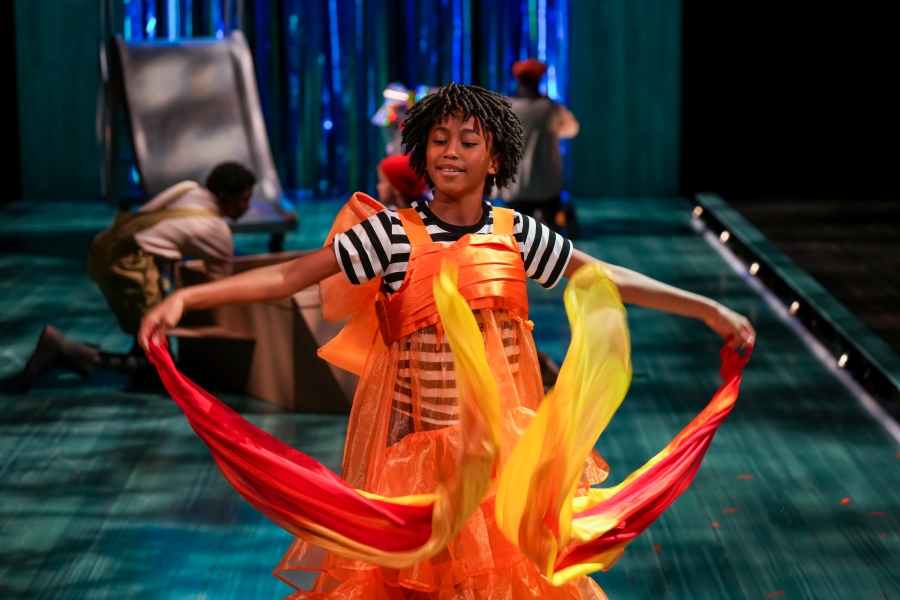Peter Brosius, artistic director of the Children’s Theatre Company (CTC) in Minneapolis, sat on the floor at the Center for Fiction Bookstore in New York reading a pile of children’s books.
Brosius had asked the bookseller to give him her 10 favorite children’s books. As he sat there reading them all (and eventually buying a few “because I’m not a horrible person,” he added), he was enchanted by the story of a young boy and his beloved tangerine dress. He instantly knew that this story, about a boy standing up against gender stereotypes and bullying in an imaginative quest of self-love and expression, needed to be told onstage.

“I loved the whimsy,” said Brosius, who is in the midst of his final season leading the theatre. “I loved the innocence. I loved the curiosity of this kid and the ability to stand his ground, the ability to bring others along—not everybody, because this is the world. But the ability to do that, it just seemed at this moment, in our nation’s history—with the weaponization of gender and the othering reaching a kind of terrible and horrific frenzy—a play like this, for the younger ones, about being who you are, about accepting others for how they wanted to be, just seemed like a very good thing to do.”
Last week, CTC’s two alternating youth casts began performances of Morris Micklewhite and the Tangerine Dress (through Nov. 19), a world premiere adaptation from playwright juliany taveras, directed by Heidi Stillman, based on Christine Baldacchino and Isabelle Malenfant’s book of the same name.
Co-commissioned by CTC, Chicago Children’s Theatre, and the Rose Theater in Nebraska, Morris Micklewhite tells the story of a young boy who finds a tangerine dress in his dress-up bin at school and immediately falls in love with it because it reminds him of “tigers, the sun, and his mother’s hair.” He wears the dress everywhere, though some kids tease him and won’t let him play in their cardboard spaceship because, they reason, “Astronauts don’t wear dresses.” Though dejected at first, Morris uses his enormous imagination and dauntless spirit to find a way to be relentlessly himself, and bring some others along on a jubilant journey of self-expression and liberation from the rigidity of gender stereotypes.
Over the past two years, from conception through development and now to Minnesota audiences, Morris and his fiery dress have inspired those who’ve been a part of it at CTC. Lurking in the corners of their excitement, though, is the specter of anti-LGBTQ+ sentiment, and attempts to ban the book that have dogged it since its publication in 2016. The book has been contested by a parent in a Michigan school district who said it encourages boys to wear dresses, challenged by a public petition in Orange City, Iowa, and burned by an Iowa activist live on Facebook.
This ferocious opposition is something even the youngest members of the cast, crew, and leadership at CTC are aware of. Brosius said that while that theatre is prepared for any potential security issues, they are encouraging conversations about the issues the play raises, and they’re hopeful that audiences will see what CTC does in Morris: courage, creativity, and unflappable resilience.

A Call to Action
Ironically, when juliany taveras was a kid, they hated to wear most dresses.
“Not because I necessarily hated dresses, or every dress that I had,” said taveras, whose work often centers queer and trans experiences. “But there was a fluffy one, and the itchy ones, and the uncomfortable ones.”
One dress—a velvet number with little hearts on it—was quite comfortable, and taveras said they would have worn it every day if they could have. It was being forced to wear dresses, even when they didn’t feel like it, that gave taveras a strong distaste for them.
Looking back, taveras wishes they’d had stories like Morris Micklewhite when they were younger, allowing young people like themself to know they could but didn’t have to wear dresses, and either way, it didn’t define them. That’s why they signed on to write the play, bringing with them their own experience breaking free of gender stereotypes and finding their own self-expression in the script.
“Any time I see something, and I’m like, ‘Wow, I wish my younger self had seen this,’ then I want to be a part of it,” they said. “I bring my personal desire to get to wake up every day and decide who I am and what I want to wear and how I want to express myself. And I think that’s Morris’s call to action.”

In addition to working with CTC on Morris Micklewhite, the New York-based multi-genre storyteller has had work developed at Page 73, the Lark, Crashbox Theater Company, Corkscrew Theater Festival, the Bechdel Group, WOW Café Theatre, Two River Theater, and Greenhouse Theater Center, among others. Their recent projects include YAELIS, a coming-of-age tale about a girl who runs away into the desert after her mother disappears, and Desarrollo, about a group of young friends who document their summer and revisit it 10 years later to find themselves and their homes very changed. Their play the anatomy of light was an honorable mention on the 2016 Kilroys list. Recently, taveras said, they’ve been on “a journey to really nourish my inner child and connect with them,” and the development process for Morris Micklewhite has delivered on both counts.
During that creative journey, taveras said working with the play’s young actors delivered inspiring moments that have made the play richer and even more in touch with the challenges kids today face growing up. For instance, Truman Bednar, a young actor playing Henry, one of the meanest bullies in the play (“Of course, he’s super sweet,” taveras stressed), wondered aloud during a workshop, “Where do you think these kids get this from? Why do you think they think this way?” Bednar ventured that maybe Henry had gotten this hateful thinking from one of his parents.
“It really helped me to flesh out those other characters,” said taveras. What had once been only Morris’s story in the first drafts grew into a story that taveras said will hopefully share with kids “a spectrum of what it means to navigate this kind of stuff.”
This, taveras said, is important, because in reality there are kids like Morris with supportive adults around them, but also many kids who don’t have that kind of support. So though the story ultimately is Morris’s story, it’s significant that he brings former bullies and naysayers along for the ride to his world, where astronauts do wear dresses and elephants and tigers make cameos on space safaris. Because Morris’s “call to action,” as taveras calls it, is for all the kids—those who feel like they can’t wear the dresses, or bow ties, or velvet tuxedo ball gowns, because gender norms (and perhaps their grown-ups) say so.

Precisely What Theatre’s For
“I love dresses,” said 11-year-old Mathias Brinda.
When Brinda was younger, they had a favorite pink tutu they wore everywhere; something about it simply brought them joy. Now, roughly a decade later, Brinda can draw on that joy to portray the character of Morris Micklewhite. Like Morris, Brinda said they know what it’s like to be bullied for who you are, so they know just how powerful a play about a boy wearing a dress can be.
“It’s about believing in yourself and doing what you want, and also the pushing of gender norms,” Brinda said. “Boundaries are being pushed, and not a lot of people are comfortable with that.”
When Brinda transferred to a new school in second grade, the bullying stopped, and now they feel more supported, even celebrated, at a school where they say several boys wear dresses. Brinda said they hope that Morris Micklewhite will help kids who may not have such a supportive environment feel not just represented but actually encouraged to be boldly themselves.
Those who have challenged the book claim that it will encourage boys to wear dresses—to which Brinda replied, “That’s the point. If it’s giving them the idea, that’s great. I personally don’t see why it needs to be banned, or why it’s important to shield that from children. If it’s a lifestyle you’re not comfortable with, then you don’t have to surround yourself with those kinds of people. But you don’t have to spew hate toward other people that have different lifestyles.”
Brosius agrees, and in fact CTC has planned several events, including post-show talk backs and a Pride Party, where young people and families are encouraged to discuss their different ideas and feelings about the play. This, Brosius said, is precisely what theatre is for—to be a sort of town hall for everyone, no matter their age or identity.
“Young people are intelligent, young people live in this world, young people need spaces where they can dive into the issues,” Brosius said. “Young people don’t live in some idyllic corner of the world. They’re dealing with moving, they’re dealing with divorce, they’re dealing with poverty issues, homelessness. I mean, they live in our world, and to deny that does no one a service, because young people are trying to figure out how to make sense of this world.”
Brosius hopes the play is a hit and that theatres across the country will decide to stage it. But even if the play never sees another stage beyond CTC’s co-producing partners, Brosius said it will be a success as long as audiences are moved when they watch Morris, though discouraged by bullies, find the strength to triumphantly put the dress back on.
“The theatre is a place where we can really have wonderful conversations about who we are,” Brosius said, “who we want to be as a nation, who we want to be as people, and the world we want to leave for our children.”
Crystal L. Paul (she/her) is a Chicago-based journalist and editor, specializing in community journalism and reporting on race and culture and the arts. @cplhouse; crystal.l.paul@gmail.com.





